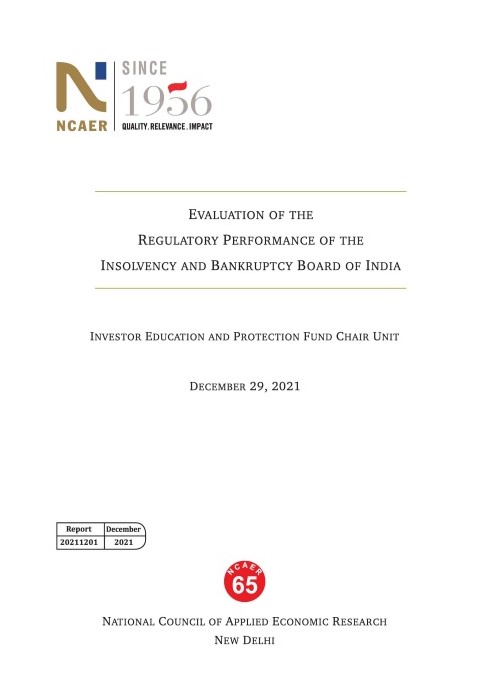Evaluation of the Regulatory Performance of the Insolvency and Bankruptcy Board of India
K P Krishnan
December 2021
The IEPF Chair Unit at NCAER prepared a Report on the perception-based external evaluation of the Insolvency and Bankruptcy Board of India (IIBI). The study was led under the guidance of Dr K.P. Krishnan, IEPF Chair Professor with a core team of staff which included Ms Amrita Pillai, Mr Sudipto Banerjee, and Mr Karan Gulati. The salient findings of the study are enumerated below:
The IBBI acts as Statutory Regulatory Authority (SRA) under Section 196 of the Insolvency and Bankruptcy Code (IBC), 2016 performing Executive, Quasi-Legislative and Quasi-judicial functions at the same time. The integration of these functions in one body poses risks as it violates the principle of separation of powers.
Therefore, a periodic review or evaluation of the performance of SRAs is a crucial measure to establish credibility and regulatory relevance. Regulatory performance evaluations in other jurisdictions are reported to have resulted in improvements in consumer protection, the internal governance arrangements of the regulator, and the legal landscape. The IBBI is a frontrunner in good regulatory practices among Indian SRAs. In its last self-evaluation, the IBBI Governing Board rated the IBBI performance as ‘93% Excellent’.
The IEPF Chair Unit at NCAER undertook the first-ever external evaluation of IBBI with the objective of assessing the regulatory quality of the institution. The framework for IBBI’s evaluation had two pillars: (i) governance, and (ii) fulfilment of statutory powers and functions. The constituent elements of the pillars were further classified under broad sub-heads with levels of achievement scores on each pillar. As many as 97 performance indicators were developed and measured on achievements. When the regulator fulfils the desired action, consistent with the Code and other benchmarks of good regulatory governance practices, it was assigned an ‘Excellent’ rating. Where there was scope to improve how an action is to be carried out, a ‘Satisfactory’ rating was assigned. In case where a written response from the regulator confirmed that an action was not yet fulfilled, or there was no publicly available evidence of the regulator fulfilling the desired action, it was rated ‘Poor’. Two other aspects of importance for the functioning of the IBBI were also recorded. The first was resource constraints - financial, human and physical - faced by the IBBI, and the second was the perception of service providers regarding their regulator. These two aspects, while recorded in a detailed manner, were not scored.
Based on the above methodology, the IBBI was rated ‘Excellent’ on approximately 77% of the total 97 indicators that were used to evaluate its performance. The IBBI was rated ‘Poor’, i.e. not undertaking the desired action, on only 6 out of the total 97 indicators used for evaluation. Stakeholder satisfaction was also assessed, and suggestions were made to improve that.
It was felt that given the schema of financial arrangements in the IBBI, it may be inappropriate to score it on actions over which it does not have complete control, but these aspects were documented in the Report. Potential areas of improvement to strengthen regulatory governance have also been highlighted along with suggestions for the future evaluations.
Investor Education and Protection Fund Chair Unit







